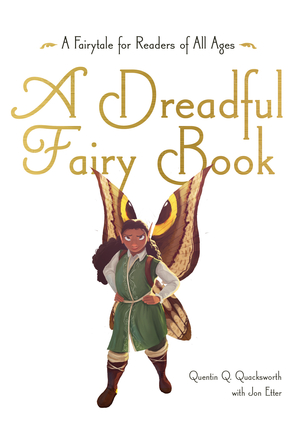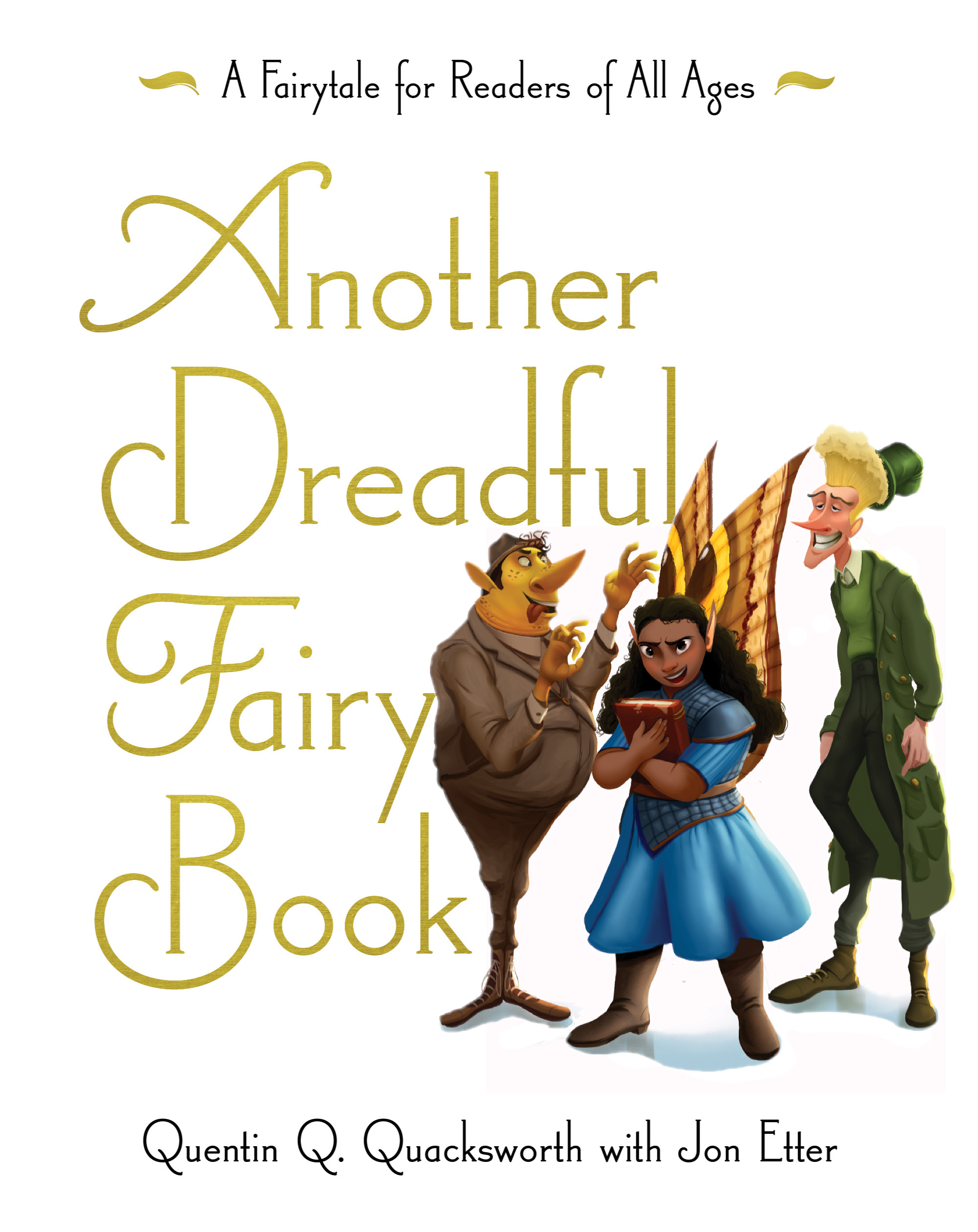A Comparative Analysis of Liminal Fairy-Human Literary Works, Complete with Jargon and an Unnecessarily Long Title to Indicate its Scholarly Nature by Jon Etter, M.A., B.A., B.S., P.U., X.O.X.O.
 Since A Dreadful Fairy Book, Book 1 of Those Dreadful Fairy Books, was published, many people have been nice enough to tell me how much they enjoyed it, and I think at least a few of them have actually been sincere. Readers have been especially quick to praise what they believe to be fairy world parodies of classic literary titles. As much as I’d like to take credit for them, the fact is that I didn’t make up a single one.
Since A Dreadful Fairy Book, Book 1 of Those Dreadful Fairy Books, was published, many people have been nice enough to tell me how much they enjoyed it, and I think at least a few of them have actually been sincere. Readers have been especially quick to praise what they believe to be fairy world parodies of classic literary titles. As much as I’d like to take credit for them, the fact is that I didn’t make up a single one.
You see, before starting the series, I thought it best that I immerse myself in fairy culture, which included a lengthy stay in the fairy realm—sort of, since the six years I spent there ended up being approximately one long weekend in the mortal realm—much of which was spent conducting research in their libraries. While there, I was amazed to find many books that bore a shocking resemblance to our own. I suppose it makes sense, given their world and ours overlap, that one world’s literature would influence the other, although which came first I couldn’t say. To illustrate this and for your edification, below is a list of a number of the works I had the pleasure of reading during my time amongst the fey folk.
The Fairy Godfather by Puzo di Corleone
Crime fiction isn’t a major genre in the fairy realm. That said, this tale of violence and intrigue amongst rival fairy gangs has become a widely read and extremely influential classic. The story largely centers on “Mumbling Don” Vito, the chipmunk-headed goblin patriarch of the Andolini crime family, and his efforts to maintain control of smuggling operations in the shipping town of Bilgewater. Fans of the book seem especially keen on quoting Mumbling Don’s catchphrase: “I’m gonna make him an offer that, if he takes the time to seriously consider its exact nature and weigh the benefits of agreeing to it versus the very injurious repercussions of declining, I think he’s likely to accept. Now please go put horse head in his bed.”
Captain Ishmael’s Ill-Advised and Ill-Fated Pursuit of the Albino Whale That Bit Off His Pinky-Toe, Featuring Extensive Passages on Whaling Lore by Sir Melville de Acuchnet
The title is pretty on the nose for this one, which begins with the iconic first line: “Call me Ishmael…because that’s my name—Ishmael. I don’t know why you would call me anything else. Well, I guess my nana did call me ‘Ishy,’ but I never liked it and you’re not my nana, so Ishmael it is.” While the central tale of monomaniacal obsession is quite gripping, approximately 80 percent of the book (reportedly written at the behest of and with generous financial support from the fairy whaling industry) is whaling-related information: how everything on a whaling ship is done, an extensive history of on the depiction of whales in literature and the visual arts, holiday-themed whale dishes, scrimshaw tutorials, etc.
Le Warte d’Arty by Sir Thomas Belletruck
The parallels between Le Warte d’Arty and Mallory’s Le Morte d’Arthur are undeniable and clearly show the influence of one on the other: both Arthur Pendragon and Arty Quillwyrm are heirs of to their respective kingdoms’ thrones raised in secret, both prove their right to rule by drawing a cutting implement from a hard object (in Arty’s case, it is an enchanted butter knife from a stale loaf of rye bread), both receive magical swords from magical women living in bodies of water (the Lady of the Lake in Arthur and the Reasonably Well-Behaved Woman in the Bog in Arty), and both works culminate in the fall of the just, chivalrous kingdom each one founded. This is not to say that there are not several major differences between them, of course. While a vision of the Holy Grail inspires the quests of various knights in Arthur, the vision of the Enchanted Goblet is met with merely a shrug from the knights in Arty, who simply continue with their feast, content in the knowledge that they already have more than enough cups to drink from. And in the end, there is relatively little trouble resulting from Sir Glancelot glancing an awful lot at the queen, the fall of Gone-a-little instead being the result of Arty’s increasingly desperate and ill-advised attempts to get rid of an unsightly wart on his chin.
Meager Expectations by Carolus the Stripling
Of the many fairy works with human-written counterparts, this one is easily the most drastic departure from the book that we all know and at least a few of us who weren’t forced to read it in high school have enjoyed. In Stripling’s tale, the main character, Wmfrre “Whumf” Waunarlwydd, is a simple country lad with the fairly meager expectations of someday becoming an eel farmer like his step-brother/surrogate father Jim Garglely, having bread and butter to eat on a semi-regular basis, and only getting beaten by his sister once or twice a day. When a rich, creepy recluse invites him to come play in her crumbling mansion, Whumf, having no interest in her wealth and influence because of his meager expectations of life (and mindful of the stranger-danger lessons he’s learned in school), declines and goes on to live a simple yet content life, marrying his childhood best friend, farming eels, and spending time with his beloved Jim and his sister, whose temperament happily improves after she is savagely bludgeoned by a disgruntled apprentice eel farmer. While admittedly lacking in the high drama of Dickens’s work, it is relatively pleasant to read about a protagonist who does not at any point become an insufferable jerk.
Pride and Pixies by Jayne Owlslyn
Greatly beloved by the more genteel amongst the fairy community, Pride and Pixies is both the most celebrated and influential love story in fairy literature and a shrewd and witty critique of upper-class fairy society. Generations of readers have enjoyed the “will-they-or-won’t-they-oh-heck-let’s-be-honest-we-know-they-will” romance between the wealthy and proud Mr. Doosey and the sharp-tongued and exceedingly judgmental Elzesplat Bunting played out amongst a pixie nobility for whom actually having to work for a living is a fate worse than death.
Jacob & Wilhelm’s Grim Tales
Compiled by the two renowned rumpelstilt researchers Jacob and Wilhelm, this collection of fairy folktales has long been a popular go-to source for fairy parents needing a bedtime story and, consequently, a regular source of nightmares for fairy children. Living up to the title of the collection, these stories feature fairy children being neglected, abused, abandoned, murdered, magically transformed, and/or eaten by wild animals, witches, relatives, or each other. Explicitly didactic in nature, the moral of roughly half of the stories is essentially, “If you don’t do exactly what your parents and elders tell you to do, you’ll die in some painful and grisly way”; the moral of the other half being, “If you do exactly what your parents and elders tell you to do, maybe you won’t die in some painful and grisly way, although, to be honest, the outlook on that isn’t great.” As you can clearly see, there’s very little difference between these and the tales of the Brothers Grimm.

The second book in the Those Dreadful Fairy Book series is available now!
No Comments
No comments yet.